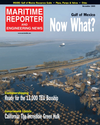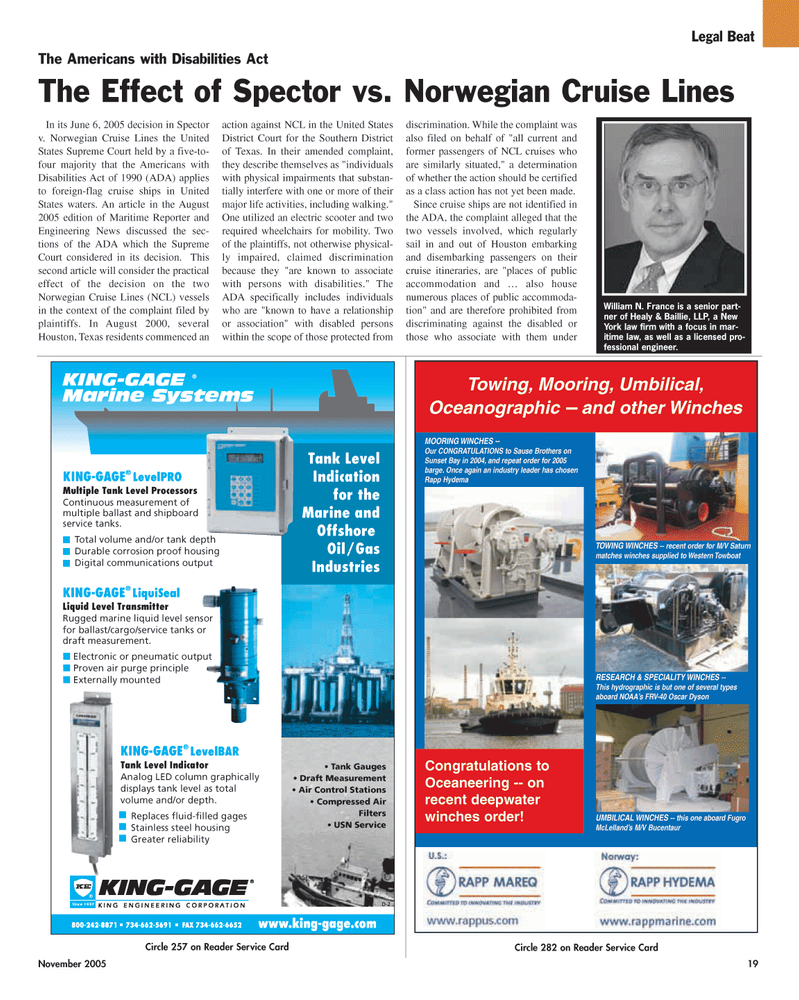
Page 19: of Maritime Reporter Magazine (November 2005)
The Workboat Annual Edition
Read this page in Pdf, Flash or Html5 edition of November 2005 Maritime Reporter Magazine
November 2005 19
KING-GAGE ®
LevelBAR
Tank Level Indicator
Analog LED column graphically displays tank level as total volume and/or depth. Replaces fluid-filled gages Stainless steel housing Greater reliability • Tank Gauges • Draft Measurement • Air Control Stations • Compressed Air
Filters • USN Service
KING-GAGE
Marine Systems ®
KING-GAGE ®
LevelPRO
Multiple Tank Level Processors
Continuous measurement of multiple ballast and shipboard service tanks. Total volume and/or tank depth Durable corrosion proof housing Digital communications output
KING-GAGE ®
LiquiSeal
Liquid Level Transmitter
Rugged marine liquid level sensor for ballast/cargo/service tanks or draft measurement. Electronic or pneumatic output Proven air purge principle Externally mounted Tank Level
Indication for the
Marine and
Offshore
Oil/Gas
Industries
D-2
Circle 282 on Reader Service CardCircle 257 on Reader Service Card
MOORING WINCHES --
Our CONGRATULATIONS to Sause Brothers on
Sunset Bay in 2004, and repeat order for 2005 barge. Once again an industry leader has chosen
Rapp Hydema
TOWING WINCHES -- recent order for M/V Saturn matches winches supplied to Western Towboat
RESEARCH & SPECIALITY WINCHES --
This hydrographic is but one of several types aboard NOAA’s FRV-40 Oscar Dyson
UMBILICAL WINCHES -- this one aboard Fugro
McLelland’s M/V Bucentaur
Towing, Mooring, Umbilical,
Oceanographic and other Winches
Congratulations to
Oceaneering -- on recent deepwater winches order!
In its June 6, 2005 decision in Spector v. Norwegian Cruise Lines the United
States Supreme Court held by a five-to- four majority that the Americans with
Disabilities Act of 1990 (ADA) applies to foreign-flag cruise ships in United
States waters. An article in the August 2005 edition of Maritime Reporter and
Engineering News discussed the sec- tions of the ADA which the Supreme
Court considered in its decision. This second article will consider the practical effect of the decision on the two
Norwegian Cruise Lines (NCL) vessels in the context of the complaint filed by plaintiffs. In August 2000, several
Houston, Texas residents commenced an action against NCL in the United States
District Court for the Southern District of Texas. In their amended complaint, they describe themselves as "individuals with physical impairments that substan- tially interfere with one or more of their major life activities, including walking."
One utilized an electric scooter and two required wheelchairs for mobility. Two of the plaintiffs, not otherwise physical- ly impaired, claimed discrimination because they "are known to associate with persons with disabilities." The
ADA specifically includes individuals who are "known to have a relationship or association" with disabled persons within the scope of those protected from discrimination. While the complaint was also filed on behalf of "all current and former passengers of NCL cruises who are similarly situated," a determination of whether the action should be certified as a class action has not yet been made.
Since cruise ships are not identified in the ADA, the complaint alleged that the two vessels involved, which regularly sail in and out of Houston embarking and disembarking passengers on their cruise itineraries, are "places of public accommodation and … also house numerous places of public accommoda- tion" and are therefore prohibited from discriminating against the disabled or those who associate with them under
Legal Beat
The Americans with Disabilities Act
The Effect of Spector vs. Norwegian Cruise Lines
William N. France is a senior part- ner of Healy & Baillie, LLP, a New
York law firm with a focus in mar- itime law, as well as a licensed pro- fessional engineer.
MR NOVEMBER 2005 #3 (17-24).qxd 10/28/2005 9:32 AM Page 19

 18
18

 20
20
